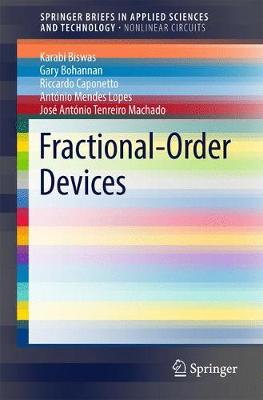SpringerBriefs in Nonlinear Circuits
1 total work
Fractional-Order Devices
by Karabi Biswas, Gary Bohannan, Riccardo Caponetto, Antonio Mendes Lopes, and Jose Antonio Tenreiro Machado
This book focuses on two specific areas related to fractional order systems – the realization of physical devices characterized by non-integer order impedance, usually called fractional-order elements (FOEs); and the characterization of vegetable tissues via electrical impedance spectroscopy (EIS) – and provides readers with new tools for designing new types of integrated circuits. The majority of the book addresses FOEs.
The interest in these topics is related to the need to produce “analogue” electronic devices characterized by non-integer order impedance, and to the characterization of natural phenomena, which are systems with memory or aftereffects and for which the fractional-order calculus tool is the ideal choice for analysis.
FOEs represent the building blocks for designing and realizing analogue integrated electronic circuits, which the authors believe hold the potential for a wealth of mass-market applications. The freedom to choose either an integer- or non-integer-order analogue integrator/derivator is a new one for electronic circuit designers. The book shows how specific non-integer-order impedance elements can be created using materials with specific structural properties.
EIS measures the electrical impedance of a specimen across a given range of frequencies, producing a spectrum that represents the variation of the impedance versus frequency – a technique that has the advantage of avoiding aggressive examinations.Biological tissues are complex systems characterized by dynamic processes that occur at different lengths and time scales; this book proposes a model for vegetable tissues that describes the behavior of such materials by considering the interactions among various relaxing phenomena and memory effects.
